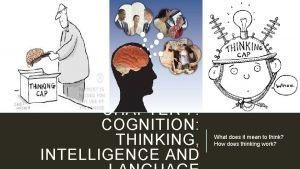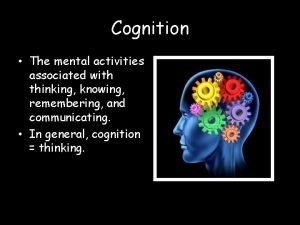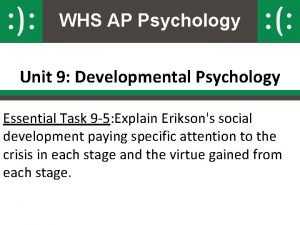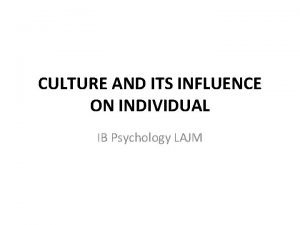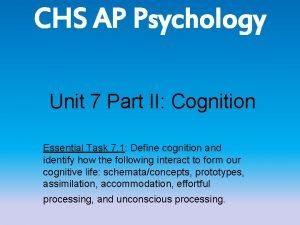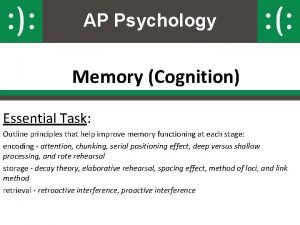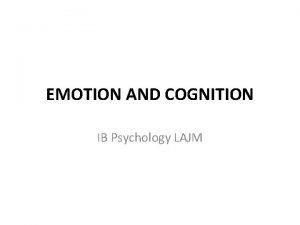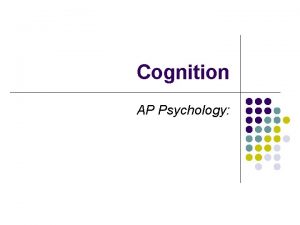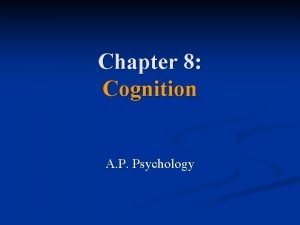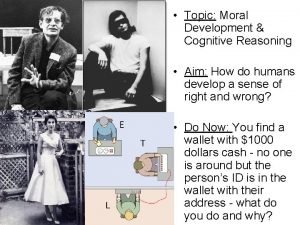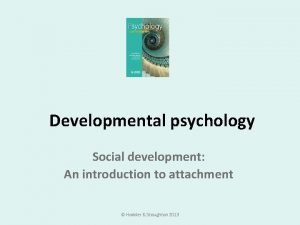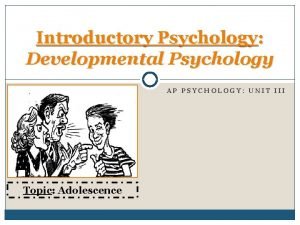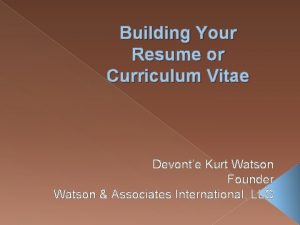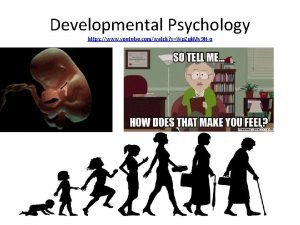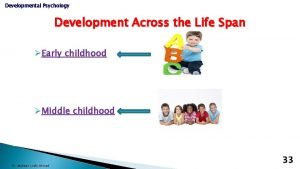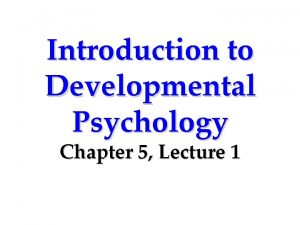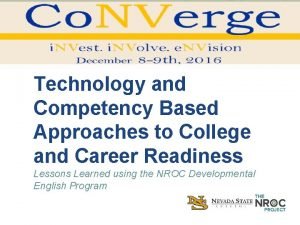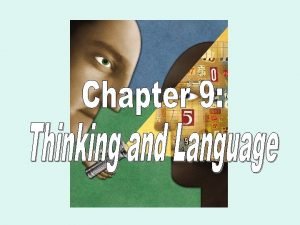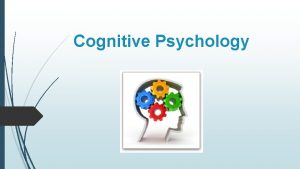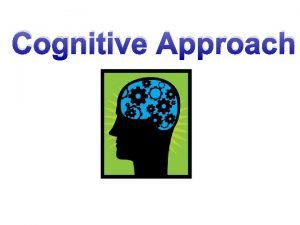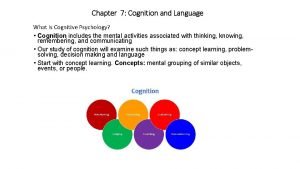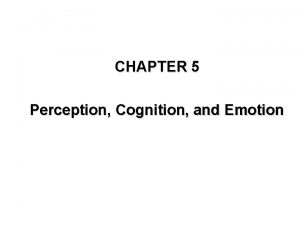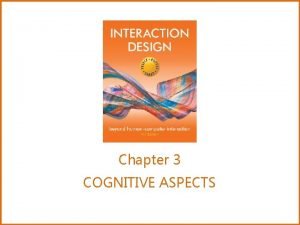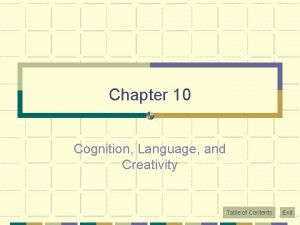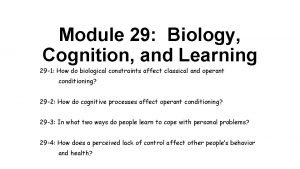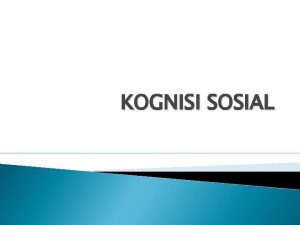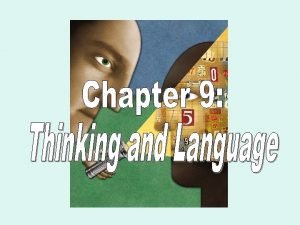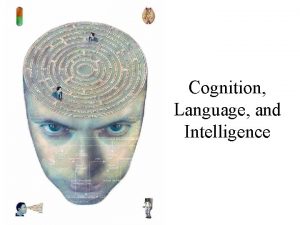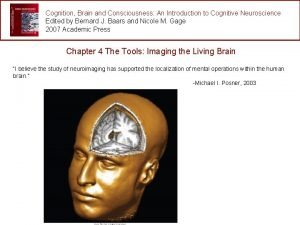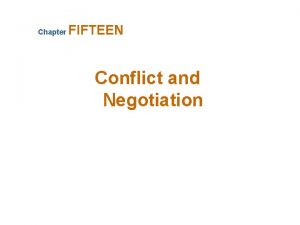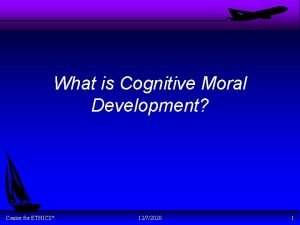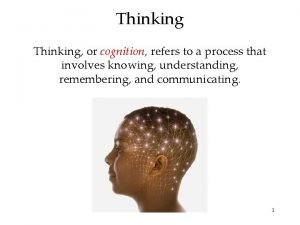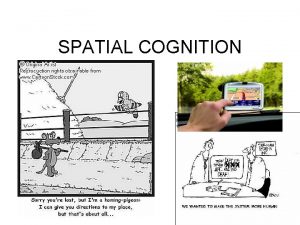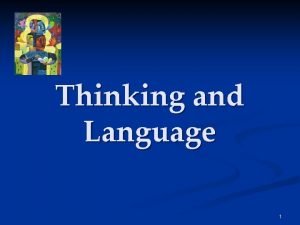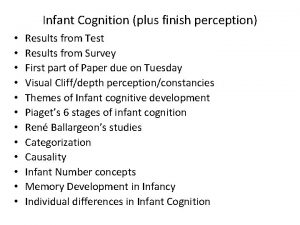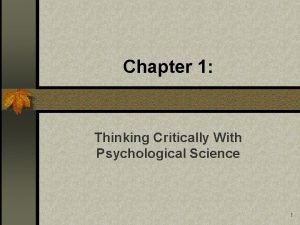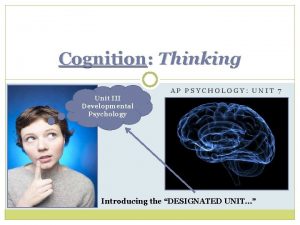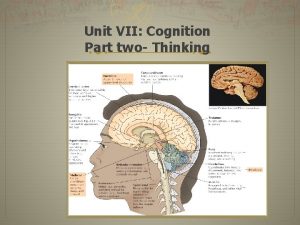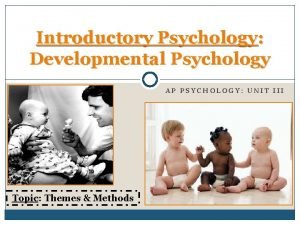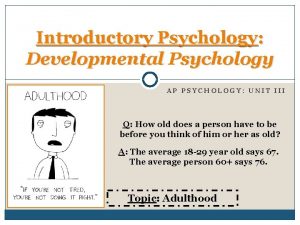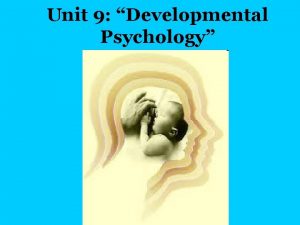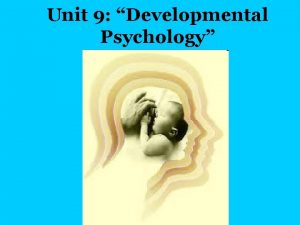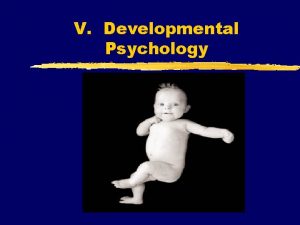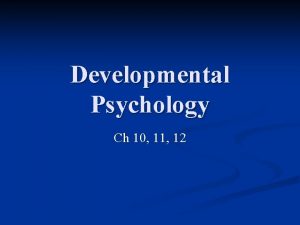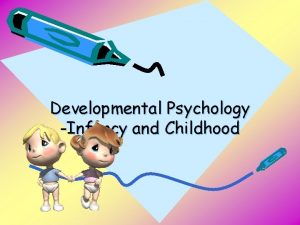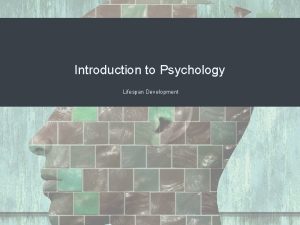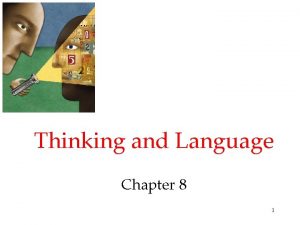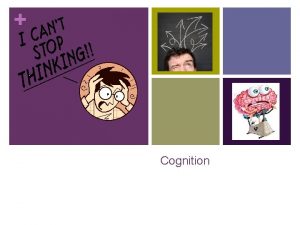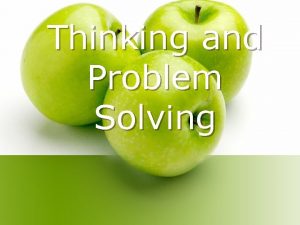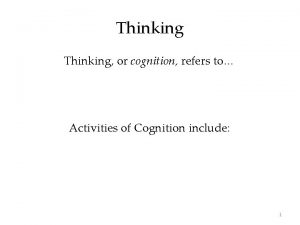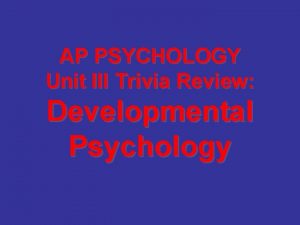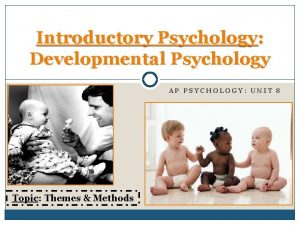Cognition Thinking Unit III Developmental Psychology AP PSYCHOLOGY





















































- Slides: 53

Cognition: Thinking Unit III Developmental Psychology AP PSYCHOLOGY: UNIT 7 Introducing the “DESIGNATED UNIT…”

Marshmallow Challenge What to do: � Build the tallest freestanding structure: the winning team is the one that has the tallest structure measured from the tabletop/surface to the top of the marshmallow. That means the structure cannot be suspended from a higher structure, like a chair, ceiling, etc � The entire marshmallow must be on top: the entire marshmallow needs to be on the top of the structure. Cutting or eating part of the marshmallow disqualifies the team. � Use as much or as little of the materials: you can use as many or as few of the 20 spaghetti sticks as much or as little of the string or tape. You cannot use any other materials � You can break up the spaghetti, string or tape: you are free to break the spaghetti and cut up the tape and string to create new structures. � The challenge lasts 18 minutes: you cannot hold onto the structure when the time runs out. Any team touching or supporting the structure at the end of the exercise will be disqualified.

Post Challenge Discussion �Where did the ideas come from for building your structure? Did everyone contribute? Were ideas received in a systematic way? Did you use a method of trial and error? Rapid prototyping? Rebuilding? Redesigning? Plan and execute? Did you fail? Did you learn from your failures? �How many standing structures are there in your classroom? Are the structures similar in design or different? What roles did team members play – leader, follower, doer, thinker, risk-taker, planner, others? Can you identify some of the key steps in the process of innovation? How did the winning team succeed? What do you think the key to their success was?

Do Now: Fact or Falsehood Worksheet �Read each statement, fill in either true or false

Cognition: The Basics PART ONE

Cognition: The Basics �Going beyond memory… How do we think? How do we create ideas? How do we solve problems? How do we make decisions? � If storage & retrieval were the only processes that we used to handle information, we would be little more than glorified VCRs �Yet, we have the ability to do something with this information… For example, we are able to combine words from our memory and create completely unique sentences �But how?

Cognition: The Basics �Cognition All of the mental activities associated with thinking, knowing and communicating Cognitive psychologists study the following mental activities… � Concepts & Prototypes � Problem Solving & Creativity � Decision Making � Judgment Formation

Cognition: The Basics �Types of Thinking Directed Thinking (Convergent Thinking) �A systematic & logical attempt to reach a specific goal or answer, such as a solution to a math problem Examples • Algorithms, heuristics, rule-bound Nondirected Thinking (Divergent Thinking) � Consists of a free flow of thoughts with no particular plan and depends more on images Examples • Brainstorming, imagination, insight, flexible, no rules

Cognition: The Basics �Metacognition The awareness of one’s own cognitive processes � In other words, metacognition is “thinking about thinking” � Example If you are having trouble solving a problem, thinking about your strategy may cause you to change strategies

Cognition: Concepts & Prototypes PART TWO

Cognition: Concepts & Prototypes �Concepts (unit of thought) A mental representation/grouping of similar objects, events, ideas or people Desk Stool Recliner � Examples Chair; fruit; animal Formal Concepts � Defined Chair by specific rules or features Natural Concepts � The result of real-world experiences �To further simplify we organize into category hierarchies

Cognition: Concepts & Prototypes �Prototype (unit of thought) An example of a concept that closely matches the defining characteristics of that concept � The most basic form of concepts � Based on one’s experiences and cultural background Fruit. . ? �I think “apple” �How do prototypes affect thinking? We use them to compare potential examples of a concept

Cognition: Problem Solving PART THREE 1. Types of Problems 2. Approaches to Solving 3. Obstacles to Solving In the Thompson family there are five brothers, and each brother has one sister. If you count Mrs. Thompson, how many females are there in the Thompson family?

Cognition: Problem Solving �Inductive v. Deductive Reasoning Inductive Reasoning � Reasoning from the specific to the general � Also known as “Bottom-Up” Logic � Examples? Deductive Reasoning � Reasoning from the general to the specific � Also known as “Top-Down” logic � Examples?

Cognition: Problem Solving �Problem Solving Active efforts to discover what must be done in order to achieve a goal that is not readily attainable � One of the primary functions of directed (convergent) thinking We all solve problems differently; however, we generally utilize the same strategies • Some may break a large problem into smaller issues • Some may combine smaller issues to create a larger problem According to psychologists, there are three basic types of problems…

Types of Problems

Cognition: Problem Solving �Inducing Structure Require people to discover relations among numbers, words, symbols or ideas Examples � Series completion problems � Analogy problems

Cognition: Problem Solving �Arrangement Require people to arrange the parts of a problem in a way that satisfies some criterion Examples � String problem � Anagram problem

Cognition: Problem Solving �Transformation Require people to carry out a sequence of transformations in order to reach a specific goal Examples � Hobbits & Orcs problem � Water jar problem

Approaches to Problem Solving

Cognition: Problem Solving �Trial & Error Involves trying possible solutions & discarding those that are in error until one works Also known as “mechanical solution” � Advantages Guarantees a solution (Works best with a small number of possibilities) � Disadvantages Often applied haphazardly; extremely inefficient

Cognition: Problem Solving �Algorithms A methodical, step-by-step procedure for trying all possible alternatives in searching for a solution to a problem � Advantages When an algorithm is available, it GUARANTEES a solution • “Solve the anagram IHCRA” � Disadvantages Can be quite inefficient • “The first person to figure out my password gets a 100% on the next test”

Cognition: Problem Solving �Heuristics A guiding principle, or “ruleof-thumb” used in solving problems or making decisions An educated guess based on prior experiences � Advantages Allows one to simplify a problem Faster than algorithms (in many cases) � Disadvantages Doesn’t necessarily guarantee a solution More prone to errors than are algorithms

Cognition: Problem Solving �Sub-Goal (a type of heuristic) Intermediate steps toward a solution � When you reach a subgoal, you’ve solved part of the problem � Some are more obvious than others Analogies Tower of Hanoi Writing a term paper

Cognition: Problem Solving �Working Backward (a type of heuristic) Works best when a problem has a well-specified end point/goal � Example The shortest route to a new restaurant in town Word problems (in many cases)

Cognition: Problem Solving �Means-End Analysis (a type of heuristic) A method in which a person determines the difference between the current situation and the goal and then tries to reduce the difference by various means

Cognition: Problem Solving �Insight A sudden & often novel realization of the solution to a problem; contrasts with strategy-based solutions � Humans are not the only animals to display insight Marsha & Mary were born on the same day of the same month of the same year to the same mother & father yet they’re not twins. . ? At the moment of insight; burst of activity in the right temporal lobe; preceded by frontal lobe activity

Obstacles to Problem Solving

Cognition: Problem Solving �Confirmation Bias The tendency to search for information that confirms one’s preconceptions & to ignore or distort contradictory evidence � Example Believers in ESP tend to remember the few studies that seem to support their beliefs, while at the same time “forgetting” the cases in which studies found no proof

Cognition: Problem Solving �Fixation The inability to see a problem from a new perspective; an impediment to problem solving � Examples Functional Fixedness Mental Set The Matchstick Problem � How would you arrange six matches to form four equilateral triangles?


Cognition: Problem Solving �Functional Fixedness A block to problem solving that comes from thinking about objects only in terms of their typical functions Candle-Mounting Problem � Using these materials, how would you mount the candle on a bulletin board?


Cognition: Problem Solving �Mental Set The tendency for people to persist in using problem-solving techniques that have worked for them in the past � Example Every time Lee plays Rock, Paper, Scissors he attempts to win using a “rock” The Nine Dot Problem � Draw four straight lines so that they pass through all nine dots without lifting your pencil from the paper & without touching any dot more than once


Cognition: Creativity PART FOUR

Cognition: Creativity �Try to think of 4 -8 things that might happen if we suddenly had three arms… �Think of as many uses for a paperclip as you can… Add up your total number of uses and divide by two Average score tends to be 4 � 2 is unusually low � 8 is unusually high � 12 is very rare � 16 makes you better than one in a thousand

Cognition: Creativity �Creativity The ability to produce novel and valuable ideas; unconventional solutions � Five components of creativity Expertise Imaginative thinking skills A venturesome personality Intrinsic motivation A creative environment � More characteristic of nondirected (divergent) thinkers Is creativity linked to intelligence?

Cognition: Decisions & Judgments PART FIVE

Cognition: Decisions & Judgments �Which airline is most dangerous to fly? �What are Zetas like? �Would Steven make a good spouse? �How likely am I to get hurt while skiing? �Is a $1, 000 deductible too high? �Is Organic Chemistry going to be a fun class? �Is this person guilty? �Is Alpharetta a good place to raise kids?

Cognition: Decisions & Judgments �Representativeness Heuristic Judging the likelihood of something in terms of how well it seems to represent, or match, particular prototypes; may lead one to ignore other relevant information � Assumes that any object that shares characteristics with the members of a particular category is also a member of that category What is one of the major problems with the representativeness heuristic?

Cognition: Decisions & Judgments Sports Illustrated Model Successful Business Man Which one of these people went to Harvard?

Cognition: Decisions & Judgments �Other Examples Whoa! You’re tall! Basketball or volleyball? You go to Milton? What type of truck do you drive? Cameron Diaz is blonde; she must be dumb… Rottweilers are attack dogs; that dog is going to attack me!

Cognition: Decisions & Judgments �Availability Heuristic Estimating the likelihood of events based on their availability in our memory; presuming that vivid memories are more common � Based on recency, vividness or distinctiveness � Why does our availability heuristic tend to lead us astray?

Cognition: Decisions & Judgments The Bronx, New York Where would you be more leery of being robbed? Gary, Indiana

Cognition: Decisions & Judgments �Other Examples I’ve never crashed my car, but planes crash all of the time! I’m never going to fly! People on welfare always abuse it. I read an article about a lady with several unruly kids who stayed on welfare for 10 years. Can you believe that? That stuff happens all of the time! Ugh! I’m so stupid. I always get Fs. I’m sure I’ll get an F on this test too!

Cognition: Decisions & Judgments

Cognition: Decisions & Judgments �Overconfidence (heuristics can lead to overconfidence) The tendency to be more confident than correct; to overestimate the accuracy of one’s beliefs & judgments � Our confidence is not a good indicator of how correct we are

Cognition: Decisions & Judgments �What percentage of crimes in the U. S. are violent? 12 percent �What percentage of accused felons plead insanity? What percentage of those are acquitted? Less than one percent; less than a quarter �What percentage of convictions for felony crimes are obtained through trial instead of plea bargaining? Less than 10 percent

Cognition: Decisions & Judgments �Belief Perseverance Maintaining a belief even after it has been proven wrong � Example “John has an IQ of 130, he must be a good student…” “He has a GPA of 1. 8. . . ” “He must be bored. . . ”

Cognition: Decisions & Judgments � Belief Bias The tendency for one’s preexisting beliefs to distort logical reasoning by making invalid conclusions � Examples Republicans are religious. Democrats aren’t Republicans. Democrats aren’t religious. God is love. Love is blind. Ray Charles is God. (Anonymous graffiti)

Cognition: Decisions & Judgments �Framing The way in which an issue is posed/framed; can significantly impact decisions & judgments (as well as memory) � Examples How should ground beef be marketed? As 25% fat or 75% lean? 90% of the population will be saved with this medication or 10% of the population will die despite this medication? You shouldn’t drink more than two drinks per day or you shouldn’t drink more than 730 drinks per year…

Cognition: Decisions & Judgments �Compensatory Model A rational decision-making model in which choices are systematically evaluated on various criteria � Examples Buying a car • MPGs, safety, comfort, design, etc. Searching for an apartment • Rent, good neighbors, good location, safety, cleanliness, etc.
 Cognition ap psych definition
Cognition ap psych definition Chapter 7 cognition thinking intelligence and language
Chapter 7 cognition thinking intelligence and language Cognition thinking intelligence and language
Cognition thinking intelligence and language All the mental activities associated with thinking
All the mental activities associated with thinking Initiative vs guilt
Initiative vs guilt Authoritariam
Authoritariam Cultural dimensions ib psychology
Cultural dimensions ib psychology Embodied cognition ap psychology
Embodied cognition ap psychology Embodied cognition ap psychology
Embodied cognition ap psychology Emotion and cognition ib psychology
Emotion and cognition ib psychology Embodied cognition ap psychology definition
Embodied cognition ap psychology definition Availability heuristic ap psychology
Availability heuristic ap psychology Embodied cognition ap psychology
Embodied cognition ap psychology Hamlet act iii scene iii
Hamlet act iii scene iii Lawrence kohlberg developmental psychology
Lawrence kohlberg developmental psychology Research methods in developmental psychology
Research methods in developmental psychology Gestalt
Gestalt John bowlby's attachment theory
John bowlby's attachment theory Personal fable ap psychology
Personal fable ap psychology Devonte is a graduate student in developmental psychology
Devonte is a graduate student in developmental psychology Ucf psychology classes
Ucf psychology classes Regression
Regression Animism examples psychology
Animism examples psychology Chapter 5 developmental psychology
Chapter 5 developmental psychology Nroc developmental english unit 6
Nroc developmental english unit 6 Positive thinking vs negative thinking examples
Positive thinking vs negative thinking examples Thinking about your own thinking
Thinking about your own thinking Linear thinking vs holistic thinking
Linear thinking vs holistic thinking Perbedaan critical thinking dan creative thinking
Perbedaan critical thinking dan creative thinking Thinking about you thinking about me
Thinking about you thinking about me Belief perseverance
Belief perseverance Cognition mse
Cognition mse Loose thought process
Loose thought process What is cognition
What is cognition Cognition definition
Cognition definition What is cognition
What is cognition Cognition vs perception
Cognition vs perception Altered cognition in older adults is commonly attributed to
Altered cognition in older adults is commonly attributed to What is cognition
What is cognition Cognition definition
Cognition definition Module 29 biology cognition and learning
Module 29 biology cognition and learning Jalan pintas mental
Jalan pintas mental Cognition refers to
Cognition refers to Similar
Similar Complex cognition
Complex cognition Cognition and personalization
Cognition and personalization Moral cognition
Moral cognition Cognition refers to
Cognition refers to Hippocampus taxi drivers
Hippocampus taxi drivers Language
Language Cognition plus
Cognition plus Unit 6 review questions
Unit 6 review questions Frustration aggression principle
Frustration aggression principle Critical thinking guidelines in psychology
Critical thinking guidelines in psychology


